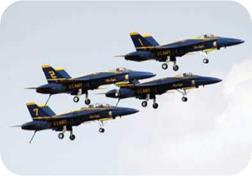Landing Gear
|
F |
or takeoff and landing-and for taxiing around the airfield-airplanes need landing gear. Usually, landing gear consists of a set of wheels attached to struts that absorb the impact of landing. Some airplanes have skis for landing on snow or floats for landing on water. Helicopters have skids or (for
water landings) pontoons. Another name for an aircraft’s landing gear is the undercarriage.
Pioneer aviators used wheels, like automobile wheels, that created drag (air resistance) in flight. One way to reduce drag was to enclose the wheels in a streamlined shape. A better way to reduce drag – and thus boost lift-was to make landing gear retractable. To achieve this, a mechanism was added to raise the wheels out of the way after takeoff and lower them for landing. The machinery added weight, however, and so the extra speed came at a cost. At speeds of around 200 miles per hour (about 320 kilometers per hour), the advantages of retractable gear were not that great. Retractable gear was introduced on 1930s planes such as Boeing’s Monomail (1930), but many smaller planes kept fixed landing gear, which was cheaper, lighter, and reliable. By the 1940s most military airplanes and passenger planes had fully retractable landing gear. The faster the airplanes flew, the more useful retractable gear became.
Conventional “tail-dragging” landing gear has three wheels. Two wheels, or sets of wheels,
О A close-up view of a landing gear bay during inspection shows how large some landing gear can be.
are positioned just in front of the airplane’s center of gravity, usually under the wings, with a smaller wheel fixed beneath the tail. On the ground, the airplane sits with its nose angled upward, resting on its tail wheel.
An airplane with “tricycle” landing gear also has three sets of wheels, but they are arranged differently. Two wheels-or up to twenty sets of wheels – are located between the center and rear of the aircraft, and a third wheel, or set of wheels, is beneath the nose. Tricycle landing gear keeps the plane horizontal on the ground, giving the pilot a better view. An aircraft with tricycle gear is also less likely to tip forward onto its nose when landing. An additional tail wheel or skid may be added to prevent damage to the tail during takeoff.
Tandem gear is used on heavy airplanes, such as the B-52. This bomber airplane has two sets of wheels, one behind the other. This tandem arrangement leaves the wings more flexible. To prevent damage to its long wings, the B-52 has a small, stabilizing wheel under each wing tip.
Mechanisms to operate the wheels include electric and hydraulic systems. Landing an airliner at over 100 miles per hour (160 kilometers per hour) puts a huge strain on the landing gear and on the wheels, which start spinning before touchdown. The struts that hold the wheels have very effective shock absorbers—hydraulic cylinders filled with oil and air-to absorb the impact of landing.
LANDING ON AN AIRCRAFT CARRIER
Airplanes such as the Hornet, designed for landing on the short runways of aircraft carriers, have tail hooks to slow them down. As they land, the tail hook catches one of several cables stretched across the deck. The cable acts like an extra brake to help stop the plane.
|
О Tricycle landing gear and tail hooks can be seen on these F/A-18C Hornet aircraft used by the U. S. Navy’s Blue Angels team as they approach for a landing. |
Landing gear takes up considerable space inside an aircraft. Some cargo planes, such the C-5 transport, have their landing gear installed in bulges on the outside of the fuselage, keeping the interior space free for freight.
N
SEE ALSO:
• Aerodynamics • Aircraft Carrier ____ . /











